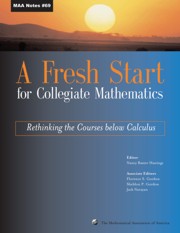Book contents
- Frontmatter
- Preface
- Contents
- Introduction
- Background
- Theme 1 New Visions for Introductory Collegiate Mathematics
- Theme 2 The Transition from High School to College
- Theme 3 The Needs of Other Disciplines
- Theme 4 Student Learning and Research
- Theme 5 Implementation
- Theme 6 Influencing the Mathematics Community
- Ideas and Projects that Work: Part 1
- 30 College Precalculus Can Be a Barrier to Calculus: Integration of Precalculus with Calculus Can Achieve Success
- 31 College Algebra Reform through Interdisciplinary Applications
- 32 Elementary Math Models: College Algebra Topics and a Liberal Arts Approach
- 33 The Case for Labs in Precalculus
- 34 The Fifth Rule: Direct Experience of Mathematics
- Ideas and Projects that Work: Part 2
33 - The Case for Labs in Precalculus
from Ideas and Projects that Work: Part 1
- Frontmatter
- Preface
- Contents
- Introduction
- Background
- Theme 1 New Visions for Introductory Collegiate Mathematics
- Theme 2 The Transition from High School to College
- Theme 3 The Needs of Other Disciplines
- Theme 4 Student Learning and Research
- Theme 5 Implementation
- Theme 6 Influencing the Mathematics Community
- Ideas and Projects that Work: Part 1
- 30 College Precalculus Can Be a Barrier to Calculus: Integration of Precalculus with Calculus Can Achieve Success
- 31 College Algebra Reform through Interdisciplinary Applications
- 32 Elementary Math Models: College Algebra Topics and a Liberal Arts Approach
- 33 The Case for Labs in Precalculus
- 34 The Fifth Rule: Direct Experience of Mathematics
- Ideas and Projects that Work: Part 2
Summary
Background
The goal of this position paper is to make the case for the use of labs in a precalculus course. The observations made in this paper are based on our experience with the precalculus program at the University of Arizona, where supplementary lab assignments are integrated into the precalculus curriculum. While these lab assignments frequently involve the use of technology, they are not computer labs in the traditional sense; rather, they are multi-step, real-life problems that students explore in a group setting.
First, we set the context for the precalculus course at the University of Arizona. All students intending to take beginning mathematics courses, including precalculus, must take a readiness test. The tests currently in use were developed in California by the Mathematics Diagnostic Testing Project. The tests primarily cover topics from algebra, geometry, and trigonometry. Most of the students who end up in the precalculus course hoped to start in first semester calculus. Most have had four years of high school mathematics ending in a course equivalent to precalculus and in some cases they have had calculus.
The precalculus course at Arizona is a four-credit course that meets in three 50-minute sessions and one two-hour lab session. The text for the precalculus course is Functions Modeling Change: A Preparation for Calculus by Connally, Hughes Hallett, et al [2]. It is followed by three semesters of the reform calculus text by the Consortium schools written by Hughes Hallett, et al [5].
- Type
- Chapter
- Information
- A Fresh Start for Collegiate MathematicsRethinking the Courses below Calculus, pp. 310 - 319Publisher: Mathematical Association of AmericaPrint publication year: 2006

